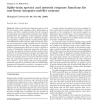Free Online Productivity Tools
i2Speak
i2Symbol
i2OCR
iTex2Img
iWeb2Print
iWeb2Shot
i2Type
iPdf2Split
iPdf2Merge
i2Bopomofo
i2Arabic
i2Style
i2Image
i2PDF
iLatex2Rtf
Sci2ools
BC
2008
2008
Spike-train spectra and network response functions for non-linear integrate-and-fire neurons
Reduced models have long been used as a tool for the analysis of the complex activity taking place in neurons and their coupled networks. Recent advanced in experimental and theoretical techniques have further demonstrated the usefulness of this approach. Despite the often gross simplification of the underlying biophysical properties, reduced models can still present significant difficulties in their analysis, with the majority of exact and perturbative results available only for the leaky integrate-and-fire model. Here an elementary numerical scheme is demonstrated which can be used to calculate a number of biologically important properties of the general class of non-linear integrate-and-fire models. Exact results for the first-passage-time density and spike-train spectrum are derived, as well as the linear response properties and emergent states of recurrent networks. Given that the exponential integrate-fire model has recently been shown to agree closely with the experimentallymeas...
BC 2008 | Elementary Numerical Scheme | Integrate-and-fire Models | Leaky Integrate-and-fire Model |
| Added | 08 Dec 2010 |
| Updated | 08 Dec 2010 |
| Type | Journal |
| Year | 2008 |
| Where | BC |
| Authors | Magnus J. E. Richardson |
Comments (0)

